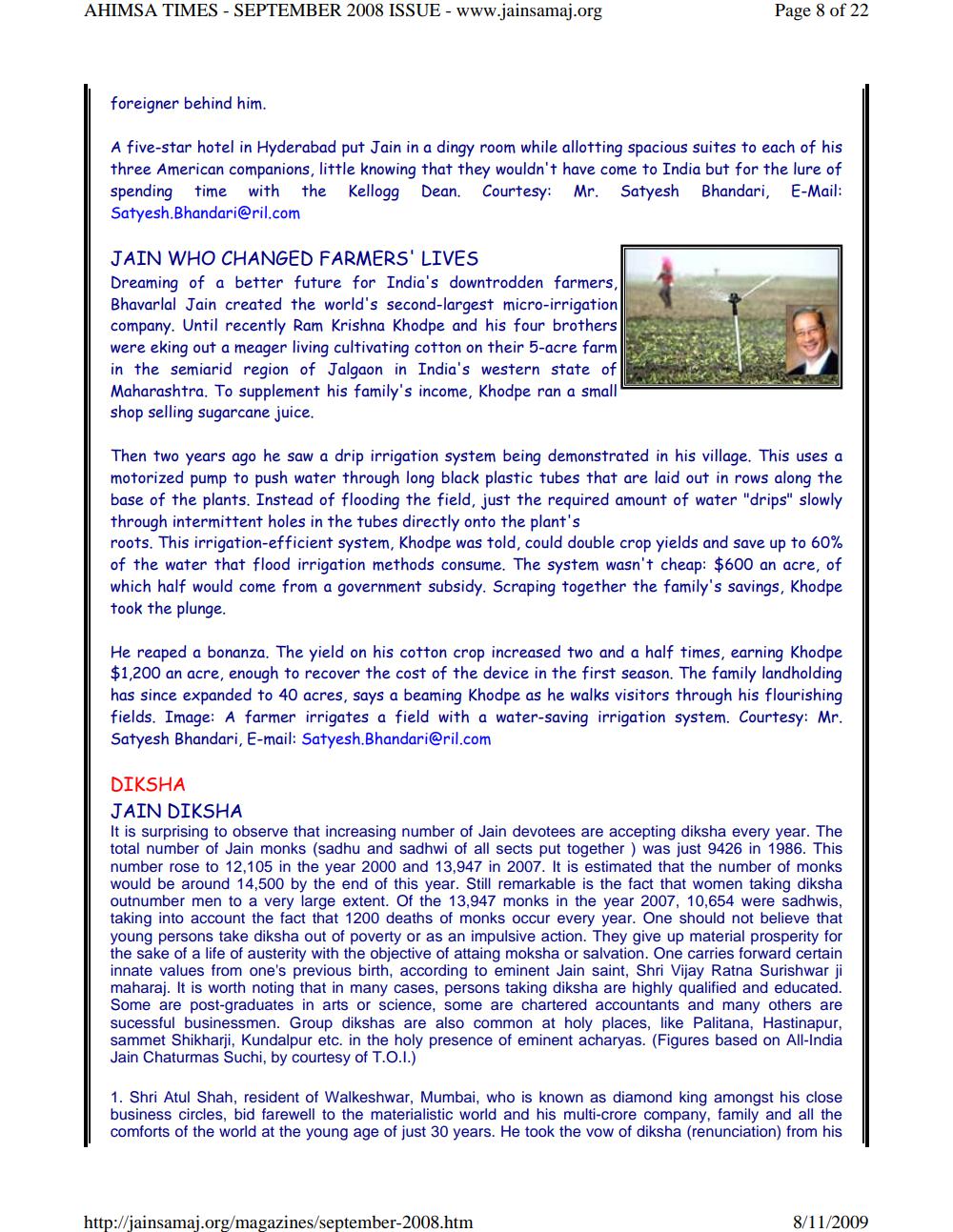________________
AHIMSA TIMES - SEPTEMBER 2008 ISSUE - www.jainsamaj.org
Page 8 of 22
foreigner behind him.
A five-star hotel in Hyderabad put Jain in a dingy room while allotting spacious suites to each of his three American companions, little knowing that they wouldn't have come to India but for the lure of spending time with the Kellogg Dean. Courtesy: Mr. Satyesh Bhandari, E-Mail:
[email protected]
JAIN WHO CHANGED FARMERS' LIVES Dreaming of a better future for India's downtrodden farmers, Bhavarlal Jain created the world's second-largest micro-irrigation company. Until recently Ram Krishna Khodpe and his four brothers were eking out a meager living cultivating cotton on their 5-acre farm in the semiarid region of Jalgaon in India's western state of Maharashtra. To supplement his family's income, Khodpe ran a small shop selling sugarcane juice.
Then two years ago he saw a drip irrigation system being demonstrated in his village. This uses a motorized pump to push water through long black plastic tubes that are laid out in rows along the base of the plants. Instead of flooding the field, just the required amount of water "drips" slowly through intermittent holes in the tubes directly onto the plant's roots. This irrigation-efficient system, Khodpe was told, could double crop yields and save up to 60% of the water that flood irrigation methods consume. The system wasn't cheap: $600 an acre, of which half would come from a government subsidy. Scraping together the family's savings, Khodpe took the plunge.
He reaped a bonanza. The yield on his cotton crop increased two and a half times, earning Khodpe $1,200 an acre, enough to recover the cost of the device in the first season. The family landholding has since expanded to 40 acres, says a beaming Khodpe as he walks visitors through his flourishing fields. Image: A farmer irrigates a field with a water-saving irrigation system. Courtesy: Mr. Satyesh Bhandari, E-mail:
[email protected]
DIKSHA JAIN DIKSHA It is surprising to observe that increasing number of Jain devotees are accepting diksha every year. The total number of Jain monks (sadhu and sadhwi of all sects put together ) was just 9426 in 1986. This number rose to 12,105 in the year 2000 and 13,947 in 2007. It is estimated that the number of monks would be around 14,500 by the end of this year. Still remarkable is the fact that women taking diksha outnumber men to a very large extent. Of the 13,947 monks in the year 2007, 10,654 were sadhwis, taking into account the fact that 1200 deaths of monks occur every year. One should not believe that young persons take diksha out of poverty or as an impulsive action. They give up material prosperity for the sake of a life of austerity with the objective of attaing moksha or salvation. One carries forward certain innate values from one's previous birth, according to eminent Jain saint, Shri Vijay Ratna Surishwar ji maharaj. It is worth noting that in many cases, persons taking diksha are highly qualified and educated. Some are post-graduates in arts or science, some are chartered accountants and many others are sucessful businessmen. Group dikshas are also common at holy places, like Palitana, Hastinapur, sammet Shikharji, Kundalpur etc. in the holy presence of eminent acharyas. (Figures based on All-India Jain Chaturmas Suchi, by courtesy of T.O.I.)
1. Shri Atul Shah, resident of Walkeshwar, Mumbai, who is known as diamond king amongst his close business circles, bid farewell to the materialistic world and his multi-crore company, family and all the comforts of the world at the young age of just 30 years. He took the vow of diksha (renunciation) from his
http://jainsamaj.org/magazines/september-2008.htm
8/11/2009
